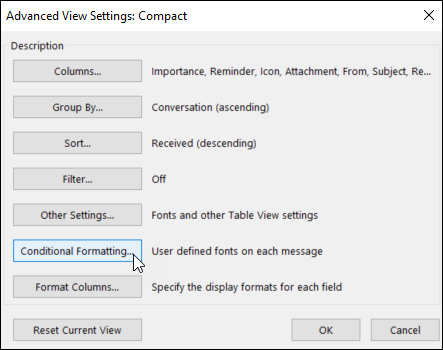Outlook for Microsoft 365 has seven predefined conditional formatting rules, like:
- Show unread emails in blue and bold font;
- Show expired emails in gray and strikethrough font;
- Show overdue emails in red font.
You can customize existing and create additional conditional formatting rules. For example:
- Make messages received from a specific person red
- Make messages sent to some address italic
- Add conditional formatting rule to highlight messages from particular people addresseddirectly to you.
- Conditional formatting is an Outlook tool for making sure your important email messages stick out in your Inbox. The tool lets you customize how different messages appear in your Inbox based on criteria that you set. This post shows you how.
- Outlook 2010/2013 conditional formatting via GPO/Script/PowerShell. Get answers from your peers along with millions of IT pros who visit Spiceworks. Our employees receive encrypted messages from time to time. In order to highlight these messages in their inbox, I would like to add a conditional formatting to every outlook client in our company.
In the Conditional Formatting dialog box, click Add. Type a name for your rule name in the Name box, and then click Condition. Select the Where I am check box, and then select either the only person on the To line, on the To line with other people, or on the CC line with other people from the drop-down list.

To create additional or configure existing conditional formatting rules, do the following:
1. On the View tab, in the Current View group, clickView Settings:
2. In the Advanced View Settings dialog box, click ConditionalFormatting...:
In the Conditional Formatting dialog box, you can see a set of default rules (also, anyconditional formatting rules that you created in the Organize pane in a previous version ofOutlook):
Outlook Conditional Formatting Cc
3. Do one of the following:
- To temporarily turn off a conditional formatting rule, clear the checkbox for that rule.
- To change the text formatting that applies to the rule, click on the rule name, and then click theFont... button to open the Font dialog box:
- To add a new conditional formatting rule, click Add to create a new rule namedUntitled and then:
- In the Name box, type a name of the new rule
- Click Font... to specify the font characteristics that Outlook for Microsoft 365 applies to themessage fields if the rule’s conditions are met
- Click Condition... to specify the criteria for this rule:
- To change the criteria for a rule, select the rule, and then click Condition... (this buttonis enabled only for user's rules, not for five predefined conditional formatting rules)
- To delete a rule, click on the rule, and then click Delete (this button is enabled only foruser's rules, not for the predefined conditional formatting rules).
Outlook Conditional Formatting Custom Color
Notes:
- The Move Up and Move Down buttons change the order of the conditional formatting rules. Outlookrules listed higher have the precedence. Lower rules extend the formatting but now overwrite it. Forexample, if the higher rule sets the font and the color, the lower rule cannot change them, but itcan make the font bold.
- The conditional formatting applies to the folders that share a view. Different views have differentconditional formatting rules.
See also this tip in French:Mise en forme conditionnelle.